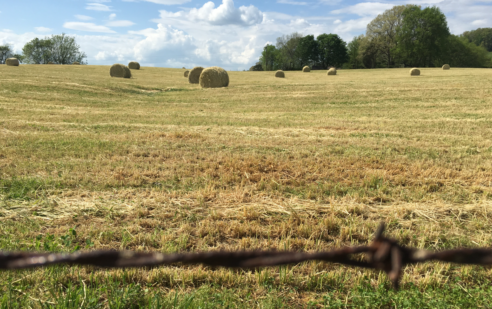

Dr. Katie Mason
Assistant Professor and Extension Beef Cattle Nutrition Specialist
Department of Animal Science
P: 865-974-8941
We often hear farmers and ranchers described as “stewards of the land.” Many entities have defined stewardship, just as they have sustainability, but this particular definition by Worrell and Appleby in the Journal of Agricultural and Environmental Ethics (2000) stood out to me: “Stewardship is the responsible use (including conservation) of natural resources in a way that takes full and balanced account of the interests of society, future generations, and other species, as well as of private needs, and accepts significant answerability to society.” It reminds us that use of the land to produce cattle should consider the interests of those around us, as well as those to come.
I have seen this concept of stewardship demonstrated clearly in recent field days where local NRCS offices, Soil Conservation Districts, and UT Extension offices have partnered to discuss grazing management practices and highlight farms that are putting those practices in place. So, what are some of the benefits of grazing management, and how to they fall under this definition of stewardship?
- Improved forage utilization – using more of the forage that is in the pasture. A continuously grazed system may result in only about 30 percent utilization, while incorporating rotational grazing practices increases that number to above 50 and even up to 70%. This creates an opportunity to support greater animal needs with the same land area.
- Decreased feed costs – in a time where input costs are incredibly high, any input that can be reduced without sacrificing performance is beneficial. Using more forage from the same amount of land is a good way to capture nutrients and dry matter for cattle and reduce hay needs.
- Better forage persistence – allowing forage plants time to rest gives them time to replenish their root energy stores. If plants are consistently overgrazed, they cannot persist for a long time. Weakened stands often have greater weed pressure, increased soil exposure, and smaller amounts of desirable forage.
- More uniform manure distribution – where do cattle typically spend time when they are not grazing? Likely in the shade or areas that are more comfortable. In areas where the tend to spend a lot of time, nutrients are excreted and accumulate in the soil. By moving cattle often and around the whole farm, we can ensure that nutrient distribution is more uniform across the area, rather than concentrated in loafing areas.
- Improved water quality – cattle need clean drinking water just as we do. Fencing off ponds reduces the extent to which cattle can stand and loaf in ponds. This practice prevents excess nutrients and bacteria from animal waste from contaminating water.
- Decreased soil erosion – exposed soil from weakened forage stands or stream banks and pond edges will retain less water and travel more easily than soil held in place by a strong root system. Maintaining a strong stand of forage and ground cover in easily eroded areas ensures that soil remains in place for the long-term.
It may seem strange for a beef cattle nutritionist to be talking about soil erosion and plant persistence. But as cattle producers, we must remember that we are grass farmers first. Recognizing the relationship between the soil, plant, and animal is vital to meeting cattle needs with forages. The interactions between all of these parts of the system must be balanced to accomplish the goal of producing beef while conserving natural resources.
It is so encouraging to be field days among producers who genuinely care about the land they manage. My favorite part might be at the end of a presentation, when new landowners come up to me with questions, excitement and passion in their voices. Or it might be when a beef producer proudly pulls out their phone to show me pictures of their cows, pastures, or rotational grazing set up. Or maybe the fellowship with people who all have a common goal. Okay, I can’t pick a favorite part… but the point is that I truly love to see proper grazing management practices implemented on farms, and I am confident that these producers are the epitome of “stewards of the land.”